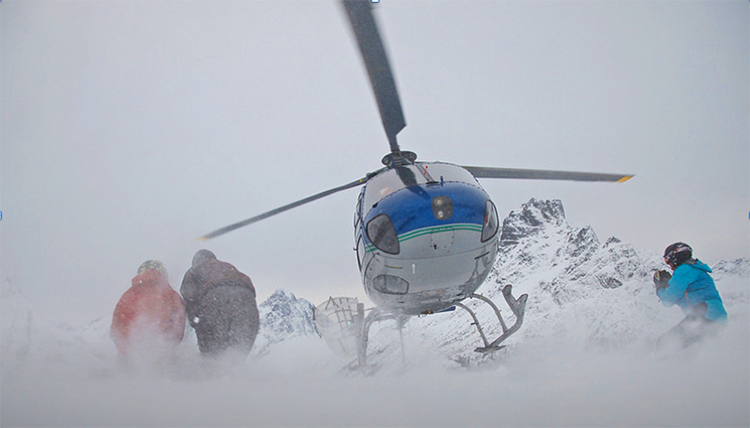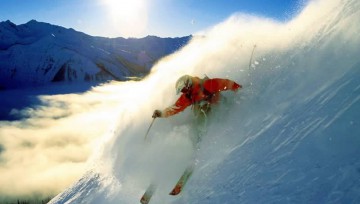For the Love of Our Clients
It has been long known to me that there is more to things than meets the eye: a depth in life that makes it challenging to know things intimately. Even simple tasks can be seemingly fathomless to master, which ultimately makes them captivating.
I have witnessed star-struck young men and women drawn to ski guide training programs thinking that they are destined for a life of play. Eying these keen individuals, I have witnessed their surprise and sometimes disheartenment upon learning that to become a ski guide takes time, commitment, hard work, and tenacity. I was one of them once, so I understand. Perhaps it is the guiding industry’s Achilles’ heel: the idea that a career in snow is not difficult, nor should it require a high level of training and professionalism. I think we need to take ourselves more seriously and strive to be consummate professionals.
It is noble to competently lead people in hazardous winter environments where those following are entrusting their own lives and the future well-being of their families. The fact is that mountains in winter are hard as hell to master. Those of us who have backcountry skied for a few years eventually lose someone we know to decisions made about snow. Backcountry skiing is not for the faint of heart and requires resilience and great humility to survive, along with a healthy measure of luck.
In December 2015 I attended the Bella Coola Heli-Sports guides’ training. Most ski guides work hard at gathering information and skill about all aspects of their vocation, but there was something that set these guides apart from others I have known, a key to gaining mastery that many have missed.
The allure of wilderness skiing for work is obvious. It is a promise of a lifetime of powder turns where your job is to always go first, without question. No jockeying for position. No being labelled a greedy shyster. You are the point person for the untracked snow that blankets the slopes below your ski tips. This is only the surface of ski guiding, and if this is what it were all about, I suspect that the guides would get bored. Managing hazards however, engages and sustains interest even in the most spirited for their entire career.
Why? It may not be self-evident but at Bella Coola I witnessed the emergence of three disciplines in their training, two are common in most guides’ training and one is not. Their guiding disciplines championed by lead guides Paul Berntsen and Jan Neuspiel are: environmental knowledge, interpersonal skill, and intra-personal awareness (knowledge about oneself). This is the kind of stuff that holds interest because all of it is fascinating.
Environmental Knowledge. Guides study their medium. There are many things in the physical world to know when it comes to leading people in this “wicked” environment. Snow is the most obvious. The white stuff is complex because it is a record of the subtleties of the winter’s weather, (and weather is a fickle phenomenon) which can produce layers that at times result in the potential for deadly avalanches. It is a constant process that can change in a very short span of time.
There are two rules that guides follow about snow. First, know as much as you can about recognizing its characteristics without making a habit of betting your and everyone else’s life on your assessments. Second, listen when it is speaking to you. Yes, it has a language and being able to heed its monologue will help to keep you alive. These two rules take fantastic discipline to adhere to and this is what the best guides do. They set aside their impulsive desires and manage the same in the group as they make choices about where to ski safely. Sometimes this means taking flak from clients who have no reference point for the worst-case scenario and who believe they have paid in order to get the goods.
The second object of study about the environment, after snow, is terrain. Ski guides are studious about mountain-scape as it relates to skiing safely. Accustomed to the mercurial nature of snow, guides study the art of putting landscape features in positive play. It is a practice of picking the slope angle and shape that is unlikely to slide regardless of snow conditions. This is called a “terrain eye” and relies on an intimate knowledge of assessing slope angle and shape. A healthy terrain discipline holds fast to the principles of “supported” terrain, which is concave in shape. Terrain is the predictable part of the backcountry skiing game, but there is an art to being able to pick and ski the sweetest line. Choose the wrong line and clients may not follow, which can lead to safety issues down the road.
Finally, guide training includes all of the hard skills development so that the guides are ready for the challenges that may come, which includes various forms of emergency response; avalanche response, crevasse rescue, and lost skiers searches.
Interpersonal. A good guide knows the social environment that is required for safety, and cultivates this environment. A safe social environment is one where all members work together in a situation to bring the important decision making information to light. The guide must be a good communicator and show the group that they are willing to listen to information from any source that will help to keep the group out of harm’s way.
Next, a first-rate guide puts the needs of the group before their own desires. I repeat: desires, not needs. It is about taking the time to manage a situation as it needs to be managed as opposed to being impatient. For example: pulling a shovel out to make a difficult traverse easy for a struggling client, where a guide could easily side slip on their own. Coaching the client step-by-step to use the right technique that matches their ability mitigates risk through action and pedagogy. This self-sacrifice is not one of the superficially alluring aspects of being a guide. It shows a level of care to attend to details and to mitigate problems before they happen, and ultimately becomes rewarding for the mature person.
Intra-Personal. Decision-making in hazardous environments is about gathering all of the available information and making a choice based on due diligence. Any military commander knows that to win a battle they have to know the personal habits of the opponent, and perhaps themself extremely well. It is personal, which can be a scary place to journey into. Tragedies are human-made. Without question, we make poor decisions if we let our egos or other unsavoury personality aspects get in the way. (See Taming Your Avalanche Dragons from December 2015)
Most impressive about Bella Coola Helisports, and what sets this operation apart from most other operations is that as an organization, the guiding staff have the courage to delve into understanding themselves individually, to see the underpinnings of their personalities and to share these with their team members. Their training is also about developing self-awareness.
Throughout history, humankind has told tales of human journeys with a moral to the story, a lesson that the hero or heroine learned or failed to learn along the way that helped them to avert or to suffer disaster. The guiding team at Bella Coola have tapped into this wisdom to make a practice of gaining insight from their experiences through reflection. This sets them apart as perhaps one of the best heli-ski guiding operations in Canada.
With great wisdom, they have embraced the practice of mastering themselves. It was refreshing to participate in their training because I came to know myself better, which will help make me a better guide. Hard training work for the entire team, in an effort to protect the client, which is perhaps an act of love.
By Ken Wylie











Comments